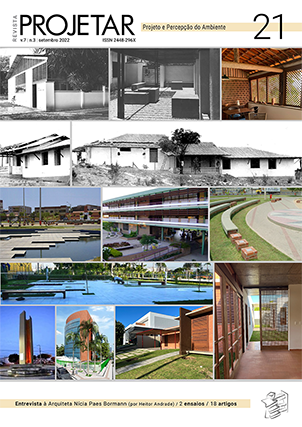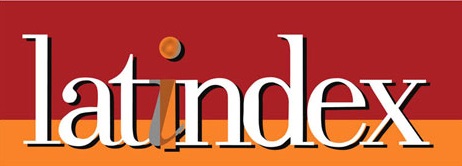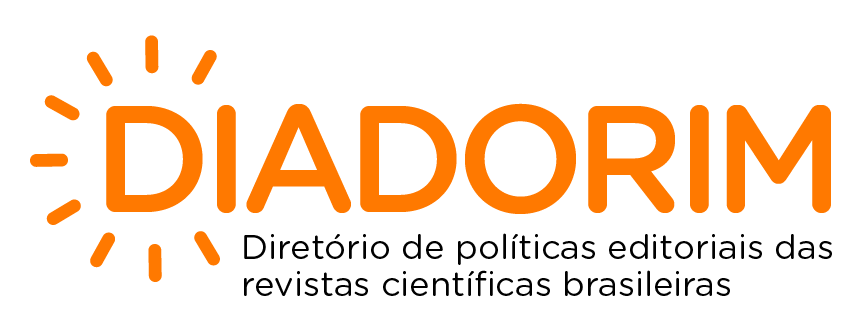ORIENTAÇÃO ESPACIAL E LEGIBILIDADE EM ESPAÇOS ABERTOS E EDIFICAÇÕES COMPLEXAS
DOI:
https://doi.org/10.21680/2448-296X.2022v7n3ID29030Palavras-chave:
orientação espacial, legibilidade, percepção dos usuários, espaços abertos, edificações complexasResumo
Este artigo pretende, com base nas percepções dos usuários, destacar as características do processo de orientação espacial em espaços abertos e em edificações complexas, e ressaltar características espaciais que facilitam ou dificultam a legibilidade em tais espaços, considerando a literatura relevante sobre o tema. Orientação espacial trata da habilidade do indivíduo em identificar sua localização e se locomover de maneira eficaz a algum destino, através de decisões tomadas com base em informações espaciais. A importância da orientação espacial e de sua consideração no ensino e na prática da arquitetura e do desenho urbano tem sido evidenciada. Contudo, a orientação espacial em espaços abertos e no interior de edificações complexas tem sido pouco considerada no ensino de arquitetura e urbanismo e, consequentemente, na prática profissional, o que justifica a elaboração deste artigo. Espera-se que as informações apresentadas contribuam para a compreensão do processo de orientação espacial, das características espaciais que facilitam ou dificultam a legibilidade para diferentes usuários, assim como para a relevância da consideração dessas características na formação de arquitetos e urbanistas e nos projetos de arquitetura e desenho urbano. Adicionalmente, este artigo reforça a importância desses projetos serem elaborados a partir das necessidades de seus usuários, incluindo a de orientação espacial, que podem estar baseadas em resultados de pesquisas já existentes e/ou novas pesquisas envolvendo tema pertinente e grupos de usuários similares.
Downloads
Referências
ABNT. NBR 9050: Acessibilidade a edificações, mobiliário, espaços e equipamentos urbanos. Acessibility to buildings, equipment and the urbano environment. 4ª edição. Rio de Janeiro: Associação Brasileira de Normas Técnicas, 147 p., 2020.
ALEXANDER, C.; ISHIKAWA, S.; SILVERSTEIN, M.; JACOBSON, M.; FIKSDAHL-KING, I.; ANGEL, S. A pattern language: towns, buildings, construction. New York: Oxford University Press, 1977.
ANDRADE, I. F.; BINS ELY, V. H. M. Orientação espacial em terminal aeroportuário: diferentes perspectivas. IN: ENANPARQ - Encontro da Associação Nacional de Pesquisa e Pós-graduação em Arquitetura e Urbanismo, 3., Arquitetura, cidade e projeto: uma construção coletiva. Anais… São Paulo, 2014.
ARTHUR, P.; PASSINI, R. Wayfinding-People, Signs, and Architecture. New York: McGraw-Hill. 2002.
BARROSO, C. P. Conforto e orientação espacial na acessibilidade universal de centros urbanos. Dissertação (Mestrado em Planejamento Urbano e Regional), Faculdade de Arquitetura, Universidade Federal do Rio Grande do Sul, Porto Alegre, 2006.
BASKAYA, A.; WILSON, C.; YAÖZCAN, Y. WAYFINDING IN ANUNFAMILIAR ENVIRONMENT: Different Spatial Settings of Two Polyclinics. Environment and Behavior, London, v. 36, n. 6, p. 839-867, 2004. DOI: 10.1177/0013916504265445
BECHTEL, R.; CHURCHMAN, A. (ed.). Handbook of environmental psychology. New York: John Wiley & Sons, 2002.
BENTLEY, I.; ALCOCK, A.; MURRAIN, P.; MCGLYNN, S.; SMITH, G. Responsive environments: a manual for designers. London: The Architectural Press, 1985.
BENTZEN, B.L. e BARLOW, J. M. e TABOR, L.S. Detectable Warnings: Synthesis of U.S. and International Practice. Berlin, Massachusetts. U.S. Access Board, 2000.
BINS ELY, V. H. M. Orientar-se no espaço: condição indispensável para a acessibilidade. In: SEMINÁRIO NACIONAL ACESSIBILIDADE NO COTIDIANO, 1, 2004. Rio de Janeiro. Anais... Rio de Janeiro: UFRJ, 2004.
BINS ELY, V.; OLIVEIRA, A. Acessibilidade em Edifício de uso público: contribuição de projeto de extensão na elaboração de dissertação. Projetar 2005 - II Seminário sobre ensino e pesquisa em projeto de arquitetura: Rebatimentos, Práticas, Interfaces. Anais… Rio de Janeiro, 2005.
BLADES, M; LIPPA, Y.; GOLLEDGE, R. G.; JACOBSON, R. D.; KITCHIN, R. M. The effect of spatial tasks on visually impaired peoples’ wayfinding abilities. Journal of Visual Impairment & Blindness, v. 96, n. 6, p. 407-419, 2002.
BROWN, B., WRIGHT, H., & BROWN, C. A post-occupancy evaluation of wayfinding in a pediatric hospital: Research findings and implications for instruction. Journal of Architectural and Planning Research, v. 14, n. 1, p. 35-51, 1997.
CARLSON, L. A.; HÖLSCHER, C.; SHIPLEY, T. F.; DALTON, R. C. Getting lost in buildings. Current Directions in Psychological Science, v. 19, p. 284-289, 2010. DOI: 10.1177/0963721410383243.
CARPMAN, J.; GRANT, M. Design that cares: planning health facilities for patients and visitors. 2. ed. Chicago: American Hospital Published, 1993.
CARPMAN, J., GRANT, M. Wayfinding: a broad view. In: BECHTEL, R.; CHURCHMAN, A. (Ed.). Handbook of Environmental Psychology. New York: John Wiley, p. 427-442, 2002.
COSTA, A. D. L.; SCARANO, L. Orientação espacial em hospital público universitário. IN: ENANPARQ - ENCONTRO DA ASSOCIAÇÃO NACIONAL DE PESQUISA E PÓS-GRADUAÇÃO EM ARQUITETURA E URBANISMO, 3., Arquitetura, cidade e projeto: uma construção coletiva. Anais… São Paulo, 2014.
CUBUKCU, E.; NASAR, J. Relation of physical form to spatial knowledge in large-scale virtual. Environmental and Behavior, London, v. 37, n. 3, p. 397-417, 2005.
CULLEN, G. Paisagem Urbana. Lisboa: Edições 70 Lda, 1971.
DOGU, U.; ERKIP, F. Spatial Factors affecting wayfinding and orientation: a case study in a shopping mall. Environment and Behavior, London, v. 32, n. 6, p. 731-755, 2000.
DOWNS, R.; STEA, D. Maps in minds. New York: Harper and Row, 1973.
ELLIS, W. C. The spatial structure of streets. IN: ANDERSON, S. (ed.) On streets: streets as elements of urban structure. Cambridge: The MIT Press, 1978.
GÄRLING, T.; BOOK, A.; LINDBERG, E. Spatial orientation and wayfinding in the designed environment: a conceptual analysis and some suggestions for post-occupancy evaluation. Journal of Architectural and Planning Research, Chicago, v. 3, n.1, p. 55-64, 1986.
GEHL, J. Cidade para pessoas. São Paulo: Perspectiva, 2013.
GOLLEDGE, R. G. Wayfinding behavior: cognitive mapping and other spatial processes. Baltimore: The Johns Hopkins University Press, 1999.
GOLLEDGE, R.; STIMSON, R. Spatial behavior: a geographic perspective. New York: Guilford, 1997.
HAQ, S. Can space syntax predict environmental cognition? In: SPACE SYNTAX INTERNATIONAL SYMPOSIUM, 2., 1999, Brasília. Proceedings… London: Space Syntax Laboratory, v. II, p. 44.1-44.14, 1999.
HAQ, S.; GIROTTO, S. Ability and intelligibility: wayfinding and environmental cognition in the designed environment. In: SPACE SYNTAX INTERNATIONAL SYMPOSIUM, 4., 2003, Londres. Proceedings... Londres: UCL, p.68.1-68.20, 2003.
HAQ, S.; ZIMRING, C. Just down the road a piece: The development of topological knowledge of building layouts. Environment and Behavior, London, v. 35, p. 132-160, 2003.
HILLIER, B.; HANSON, J. The social logic of space. Cambridge: Cambridge University, 1984.
HILLIER, B.; IIDA, S. Network and psychological effects in urban movement. In: COHN, A.G.; MARK, D.M. (Eds.) Proceedings of Spatial Information Theory: International Conference, COSIT 2005, Ellicottsville, N.Y., U.S.A., 14 set. 2015. Springer-Verlag: Berlin, Germany, p. 475-490, 2005.
HOLANDA, F. A determinação negativa do movimento moderno. In: HOLANDA, F. (Org.). Arquitetura & urbanidade. São Paulo: ProEditores, 2003.
HÖLSCHER, C.; MEILINGER, T.; VRACHLIOTIS, G.; BRÖSAMLE, M.; KNAUFF, M. Up the down staircase: Wayfinding strategies in multi-floor buildings. Journal of Environmental Psychology, v. 26, p. 284-299, 2006. DOI:10.1016/j.jenvp.2006.09.002.
HOLSTON, J. A cidade modernista: uma crítica de Brasília e sua utopia. Tradução: Marcelo Coelho. São Paulo: Companhia das Letras, 1993.
JACOBSON, R.D. Talking tactile maps and environmental audio beacons: An orientation and mobility development tool for visually impaired people, Proceedings of the ICA Commission on maps and graphics for blind and visually impaired people…, 21-25 October, Ljubjiana, Slovenia, 1996.
KAPLAN, S.; KAPLAN, R. Cognitive and environment: functioning in an uncertain world. Michigan: Ulrich's Bookstore, 1983.
KITCHIN, R. M. Cognitive maps: what are they and why study them? Journal of Environmental Psychology, v. 14, p. 1-19, 1994.
KOHLSDORF, M. E. Orientation and identification in the great Brasilia. IASTE Working Series. Berkeley: University of California Press (EUA), p. 49-82, 1996.
KRUPAT, E. People in cities: the urban environment and its effects. Cambridge: Cambridge University Press, 1985.
KUIPERS, B. The Map in the Head. Environment and Behavior, London, v. 14, n. 2, p. 202-220, 1982.
KULIGA, S.; DALTON, R.C.; HÖLSCHER, C. Aesthetic and Emotional Appraisal of the Seattle Public Library and its relation to spatial configuration. In: KIM, Y. O.; PARK, H. T.; SEO, K. W. (Eds.) INTERNATIONAL SPACE SYNTAX SYMPOSIUM, 9, Seoul, 2013. Proceedings… Seoul, p. 077: 1 - 077: 17, 2013.
KULIGA, S.; NELLIGAN, B; DALTON, R.; MARCHETTE, S., SHELTON, A.; CARLSON, L; HÖLSCHER, C. Exploring Individual Differences and Building Complexity in Wayfinding: The Case of the Seattle Central Library. Environment and Behavior, v. 51, n. 5, p. 622– 665, 2019. DOI: 10.1177/0013916519836149
LANG, J. Creating architectural theory: The role of the behavioral sciences in environmental design. New York: Van Nostrand Reinhold, 1987.
LOCATELLI, L. Orientação espacial e características urbanas. Dissertação (Mestrado em Planejamento Urbano e Regional), Faculdade de Arquitetura, Universidade Federal do Rio Grande do Sul, Porto Alegre, 2007.
LYNCH, K. The image of the city. Cambridge: The M.I.T. Press, 1960.
LYNCH, K. A theory of good city form. Massachussets, U.S.: MIT Press, 1981.
LI, R.; KLIPPEL, A. Wayfinding Behaviors in Complex Buildings: The Impact of Environmental Legibility and Familiarity. Environment and Behavior, v. 48, n. 3, p. 482 - 510, 2016. DOI: 10.1177/0013916514550243.
MANO, C. M. 2016. Orientação espacial em desenho urbano tradicional e modernista: estudo em campi universitários da UFRGS. Dissertação (Mestrado em Planejamento Urbano e Regional), Faculdade de Arquitetura, Universidade Federal do Rio Grande do Sul, Porto Alegre, 2016.
MARCHAND, D. Representation of the city and image of the centre in two different urban structures: a modern and a traditional town. In: MOSER, G., POL, E., BERNARD, Y., BONNES, M., CORRALIZA, J.; GIULIANI, M. V. (Eds.) Metropolis 2000 - Which Perspectives? Cities, Social Life and Sustainable Development. Proceedings... IAPS 16 Conference, 2000.
MOORE, G. T.; GOLLEDGE, R. G. (Eds.) Environmental knowing: theories, research, and methods. Stroudsburg, Pa: Dowden, Hutchinson & Ross, p. 3-24, 1976.
O’NEILL, M. J. Evaluation of a conceptual model of architectural legibility. Environment and Behavior, London, v. 23, p. 259-284, 1991.
OVSTEDAL, L.R. e LID, I.M. e LINDLAND, T. How to evaluate the effectiveness of a tactile surface indicator system. International Congress Series 1282, p. 1046-1055, 2005.
PASSINI, R. Wayfinding in complex buildings: An environmental analysis. Man-Environment Systems, v. 10, p. 31-40, 1980.
PASSINI, R. Wayfinding: a conceptual framework. Urban Ecology, n.5, p.17-31, 1981.
PASSINI, R. Spatial representations: A wayfinding perspective. Journal of Environmental Psychology, v. 4, p. 153–164, 1984.
PASSINI, R. Wayfinding in architecture. New York: Van Nostrand Reinhold, 1992.
PASSINI, R. Wayfinding design: logic, application and some thoughts on universality. Design Studies, n.17, p.319-331, 1996.
PASSINI, R. Wayfinding: backbone of graphic support systems. In: Visual information for everyday use Design and research perspectives. Eds. ZWAGA, Harm J.G. e BOERSEMA, Theo. Taylor & Francis-Library, Philadelphia, PA, 371 p. 241-256, 2004.
PEPONIS, J.; ZIMRING, C.; CHOI, Y. K. Finding the building in wayfinding. Environment and Behavior, v.22, n.5, p. 555-590, 1990.
PORTEOUS, D.J. Environmental Aesthetics – ideas politics and planning. London and New York: Routledge, 1996.
PRESTOPNIK, J.; ROSKOS – EWOLDSEN, B. The relations among wayfinding strategy use, sense of direction, sex, familiarity, and wayfinding ability. Journal of Environmental Psychology, v. 20, p. 177- 191, 2000.
RAPOPORT, A. Human aspects of urban form: towards a man - environment approach to urban form and design. Oxford: Pergamon Press. Urban and regional planning series, v. 15, 1977.
REIS, A. Repertório, Análise e Síntese: uma introdução ao projeto arquitetônico. Porto Alegre: Editora da UFRGS, 2002.
REIS, A. T. L. Forma urbana tradicional e modernista: uma reflexão sobre o uso e estética dos espaços urbanos. Arquisur Revista, v. 6, p. 70-87, 2014.
REIS, A. T.; LAY, M. C. D.; PORTELLA, A. Orientação espacial em conjuntos habitacionais: sinalização, configuração espacial e marcos referenciais. In: ENTAC – XI Encontro Nacional de Tecnologia no Ambiente Construído. Florianópolis/ SC, 2006. Anais… Porto Alegre: ANTAC, 2006.
REIS, A. T.; MARQUETTO, C.; LAY, M. C. D. Acessibilidade, orientação espacial e ocupação dos espaços abertos em conjuntos habitacionais. In: ENTAC – XI Encontro Nacional de Tecnologia no Ambiente Construído. Florianópolis/ SC, 2006. Anais… Porto Alegre: ANTAC, 2006.
STEA, D. Architecture in the Head: Cognitive Mapping. In: LANG, J.; BURNETTE, C.; MOLESKI, W.; VACHON, D. Designing for human behavior: architecture and the behavioral sciences. Pennsylvania: Dowden, Hutchinson & Ross, Inc., p. 157-168, 1974.
TRANCIK, R. Finding lost space: theories of urban design. New York: Van Nostrand Reinhold, 1986.
von MEISS, P. Elements of Architecture - From form to place. London: E & FN Spon, 1993.
WEISMAN, J. Evaluating architectural legibility: Wayfinding in the built environment. Environment and Behavior, v.13, n.2, p.189-204, 1981.
ZIMRING, C. The Cost of Confusion: Non-monetary and monetary costs of the Emory University Hospital Wayfinding System. Unpublished manuscript. Atlanta Georgia Institute of Technology, 1990.
Downloads
Publicado
Como Citar
Edição
Seção
Licença
Copyright (c) 2022 Márcia Azevedo de Lima, Fabiana Bugs Antocheviz, Debora Gregoletto, Antônio Tarcísio da Luz Reis

Este trabalho está licenciado sob uma licença Creative Commons Attribution-NonCommercial-ShareAlike 4.0 International License.
Autores que publicam nesta revista concordam com os seguintes termos:
- Autores mantém os direitos autorais e concedem à revista o direito de primeira publicação, sendo o trabalho licenciado sob a licença Creative Commons Atribuição-NãoComercial-CompartilhaIgual segundo a qual é permitido o compartilhamento do trabalho com reconhecimento da autoria e publicação inicial nesta revista.
- Autores têm autorização para assumir, separadamente, contratos adicionais para distribuição não-exclusiva da versão do trabalho publicada nesta revista (ex.: publicar em repositório institucional ou como capítulo de livro), desde que com reconhecimento de autoria e publicação inicial nesta revista.
- Autores têm permissão e são estimulados a publicar e distribuir seu trabalho online (ex.: em repositórios institucionais ou na sua página pessoal) desde que concluído o processo editorial, já que isso pode gerar alterações produtivas, bem como aumentar o impacto e a citação do trabalho publicado (Veja O Efeito do Acesso Livre).
- Não recomenda-se publicação e distribuição do artigo antes de sua publicação, pois isso poderá interferir na sua avaliação cega pelos pares.








